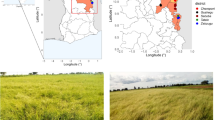Abstract
Wild species ofManihot are progenitors of cassava. They constitute valuable genetic reservoirs with genes of new characters. Study of geographic distribution of wildManihot species showed concentration of wild species in a number of centers in South and Central America. Considering Vavilov’s concept of centers of diversity based on the Age and Area hypothesis of Willis, and Harlan’s theory of Introgression, and by studying Indian immigrations in Pre-Columbian times, it is assumed that northern Amazonia is the place of domestication of cassava and that Goias is the primary center of diversity ofManihot species as a “biological group”.
Similar content being viewed by others
Literature Cited
Abraham, A. 1975. Breeding of tuber crops in India. Jour. Genet. & Pl. Br. 17: 212–217.
Boluis, G. G. 1953. A survey of some attempts to breed cassava varieties with high content of protein in the roots. Euphytica 20: 107–112.
Carlos Borges Schmidt. 1951. A mandioca, contribuicao para o cohecimento de sua origin. Boletim da Agricultura no. 1: 1.
Cruz, N. D. 1968. Citologia no generoManihot Adans. 1. Determinação do numero de cromossomo en algumas especies. Anal. Acad. Bras. Ci. 40: 81–95.
Dobzhansky, T. 1973. Genetica do processo evolutive Tradução de Celso Abbade Mourão. São Paulo, Poligono ed. 453 p.
Frankel, O. H. andE. Bennett. 1970. Genetic resources in plants. Their exploration and conservation. IBP, Blackwell, Oxford.
Jennings, D. L. 1959.Manihot melanobasis Muell. Arg. A useful parent for cassava breeding. Euphytica 8: 157–162.
Lanjouw, J. 1939. Two interesting species ofManihot from Suriname. Rec. Trav. Bot. Neerl. 36: 543–549.
Magoon, M. L., I. S. Jos andS. G. Appan. 1966. Cytomorphology of interspecific hybrid between between cassava and ceara rubber. Chromosome Infor Serv. (Japan) 8–10.
Mueller, J. 1874. Euphorbiaceae.In: Martius’ Flora Brasiliensis. Vol. XXI, pars II.
Nichols, R. F. W. 1947. Breeding cassava for resistance. E. Afr. Agr. J. 12(3): 184–194.
Rogers, D. J. 1963. Studies onManihot esculenta Crantz and related species. Bull. Torrey Bot. Cl. 99: 43–54.
Rogers, D. J. andS. G. Appan. 1973. Flora Neotropica. Monograph no. 13.Manihot. Hafner Press. New York.
Schmidt, C. B. 1951. A mandioca, contribuiçao para o conhecimento de sua origin. Boletim da Agricultura no. 1:1.
Stebbins, G. L. 1950. Variation and evolution in plants. Columbia Press, New York.
Vavilov, N. I. 1951. Phytogeographic basis of plant breeding. The origin, variation, immunity and breeding of cultivated plants. Chronica Bot. 13: 1–366.
Author information
Authors and Affiliations
Additional information
Supported by a grant from the International Institute of Tropical Agriculture (IITA), Ibadan, Nigeria and the International Development Research Centre, Ottawa, Canada.
Rights and permissions
About this article
Cite this article
Nassar, N.M.A. Conservation of the genetic resources of cassava (Manihot Esculenta) Determination of wild species localities with emphasis on probable origin. Econ Bot 32, 311–320 (1978). https://doi.org/10.1007/BF02864705
Received:
Accepted:
Issue Date:
DOI: https://doi.org/10.1007/BF02864705




